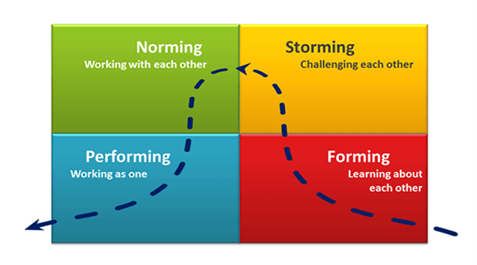“These recruits are entrusted to my care. I will train them to the best of my ability. I will develop them into smartly disciplined, physically fit, basically trained Sailors. I will instill in them, and demonstrate by my own example, the highest standards of Honor, Courage, and Commitment.”
This was the Recruit Division Commander’s (RDC) creed when I trained future U.S. Navy Sailors at Recruit Training Command (RTC) in Great Lakes, IL. The creed contained succinct and clearly defined goals that helped me, and others, successfully train 10 recruit divisions.
How did we do it? Using Tuckman’s Model to illustrate team lifecycles, Adair’s Model to illustrate leadership processes, and a Cross Functional Team Integration concept, I’ll demonstrate how three separate teams (Recruits, RDCs, and Support) came together every week to change civilians into Sailors who are ready for follow-on training and service to the fleet.
Team Building, Tuckman’s Model
Bruce Tuckman asserts that teams navigate four phases: forming, storming, norming, and performing. Tuckman’s model established that each phase is necessary for the team to grow, overcome challenges, and deliver results.

This is what Tuckman’s model looks like at Navy boot camp.
Forming
On the day recruits arrive, they are assigned to a division of approximately 88 civilians. Prior to their arrival, an entire support staff prepares for every need or incident that can arise during training. In addition, a team of RDCs is assigned to that division and familiarizes themselves with the upcoming, intense, 2-month boot camp schedule. Processing days, including day of arrival, take 3 to 5 days to complete; akin to herding cats, these forming days are the most challenging days for all teams, yet everyone has one goal in mind: graduation.
Storming
Each day, between 4:30 and 6am, recruits are awakened by “reveille”. The first person to greet them is their RDC, barking out instructions for all to hear, and preparing each future Sailor for the day’s events. Their day flow includes uniform of the day, assemble for breakfast, march, arrive at medical, eat lunch, become familiarized with training standards, attend classroom instruction, have dinner, conduct hygiene and evening routine (letters home) and more! Lights go out at 10pm, which is called “taps”. During the storming phase, recruit leadership is identified and established. Though at first they are usually hesitant to step forward, those with apparent leadership skills or High School ROTC experience will stand out and be appointed to lead in several different roles.
Norming
After only a few days, a routine takes hold and divisions, RDC’s, and supporting teams norm and begin to function like clockwork. The strict scheduling of events, and common goals provide a foundation for stability. Along with proper assignment of roles and responsibilities and repetition of a few basic functions, training is in full swing. Practice inspections, practice marching, and practice for everything is the norm. This phase lasts from approximately week 2 until week 6. Then the heat turns up!
Performing
Leading up to graduation, recruits and RDCs alike are encouraged to strive for excellence throughout training and receive recognition for outstanding performance in several areas. Everything they have practiced for the last several weeks will now be graded. Physical training, inspections, academics, and other disciplines are meticulously observed and judged by exacting standards. The results of which, if positive, are rewarded with recognition flags and pennants displayed during graduation in front of families, peers, and leadership at a graduation ceremony.
Every week new divisions form, while other divisions graduate. New teams of RDCs are assigned to train the next cycle. Some RDCs rotate into the support staff, while others return from their supporting roles. It’s a never-ending cycle of team building. How does it all go so smoothly? Quite simply, leadership.
In part 2 of this blog, we will discuss Adair’s Model of team building and three tips you can use.
What teams are in your organization? Have you assembled the right team? Is the team focused on a common goal? Does your communication system allow you to interact with other teams effectively and efficiently? Is the team forming, storming, norming or performing?
Let’s share experiences. Leave a comment below, send me an email, or find me on Twitter.
Written by Curt Kline, CHCI employee

